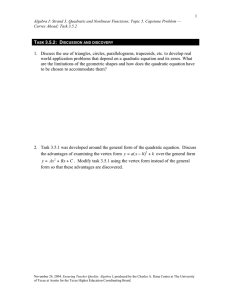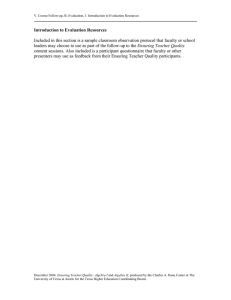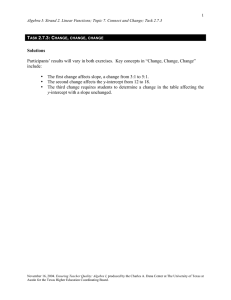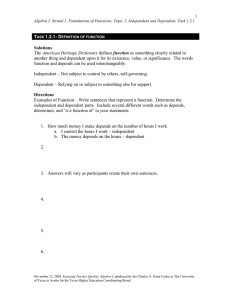Document 11665424
advertisement
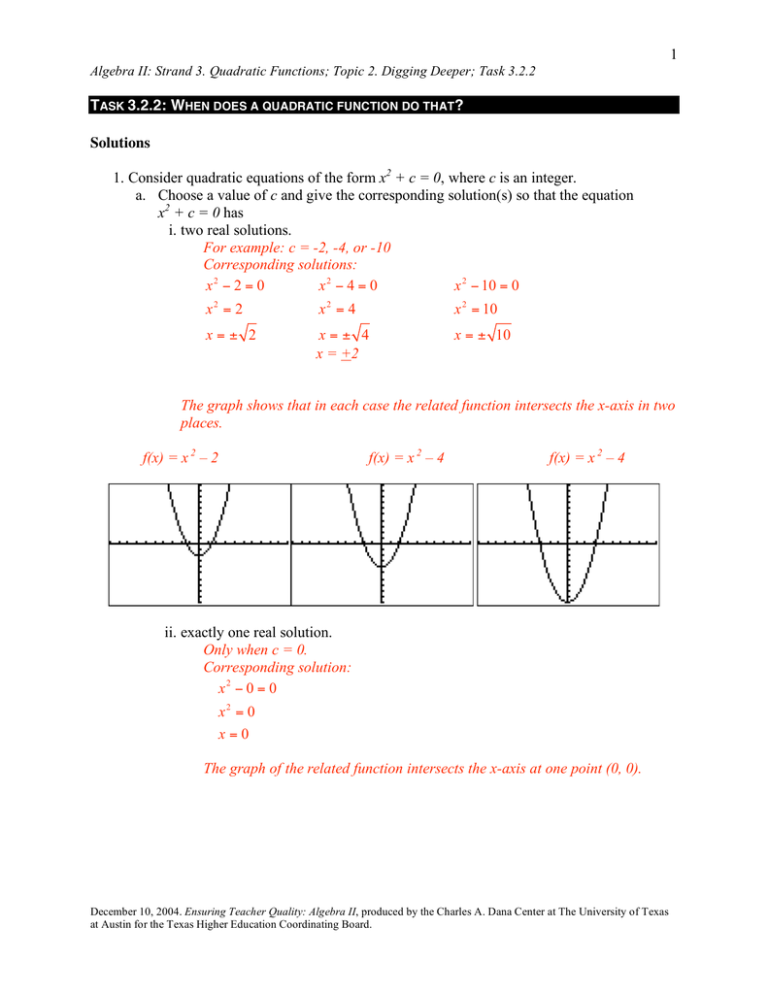
1 Algebra II: Strand 3. Quadratic Functions; Topic 2. Digging Deeper; Task 3.2.2 TASK 3.2.2: WHEN DOES A QUADRATIC FUNCTION DO THAT? Solutions 1. Consider quadratic equations of the form x2 + c = 0, where c is an integer. a. Choose a value of c and give the corresponding solution(s) so that the equation x2 + c = 0 has i. two real solutions. For example: c = -2, -4, or -10 Corresponding solutions: x2 ! 2 = 0 x2 ! 4 = 0 x 2 ! 10 = 0 x2 = 2 x2 = 4 x 2 = 10 x=± 2 x=± 4 x = +2 x = ± 10 The graph shows that in each case the related function intersects the x-axis in two places. f(x) = x 2 – 2 f(x) = x 2 – 4 f(x) = x 2 – 4 ii. exactly one real solution. Only when c = 0. Corresponding solution: x2 ! 0 = 0 x2 = 0 x=0 The graph of the related function intersects the x-axis at one point (0, 0). December 10, 2004. Ensuring Teacher Quality: Algebra II, produced by the Charles A. Dana Center at The University of Texas at Austin for the Texas Higher Education Coordinating Board. 2 Algebra II: Strand 3. Quadratic Functions; Topic 2. Digging Deeper; Task 3.2.2 iii. no real solutions. For example: c = 2, 4, or 10. Corresponding solutions: x2 + 2 = 0 x2 + 4 = 0 x 2 + 10 = 0 x 2 = !2 x 2 = !4 x 2 = !10 x = ± !2 x = ± !4 x = ±2i x = ± !10 x = ±i 2 x = ±i 10 The graph shows that in each case the related function does not intersect the x-axis. f(x) = x 2 + 2 f(x) = x 2 + 4 f(x) = x 2 + 4 b. What must be true about c in order for the equation x2 + c = 0 to have i. two real solutions? x2 + c = 0 x 2 = !c Two real solutions when c < 0. x = ± !c ii. exactly one real solution? Exactly one real solution when c = 0. iii. no real solutions? No real solutions when c > 0. 2. Consider quadratic equations of the form x2 + 2x + c = 0, where c is an integer. December 10, 2004. Ensuring Teacher Quality: Algebra II, produced by the Charles A. Dana Center at The University of Texas at Austin for the Texas Higher Education Coordinating Board. 3 Algebra II: Strand 3. Quadratic Functions; Topic 2. Digging Deeper; Task 3.2.2 a. Choose a value of c and give the corresponding solution(s) so that the equation x2 + 2x + c = 0 has i. two real solutions. For example: c = 0, -2, or -3. December 10, 2004. Ensuring Teacher Quality: Algebra II, produced by the Charles A. Dana Center at The University of Texas at Austin for the Texas Higher Education Coordinating Board. 4 Algebra II: Strand 3. Quadratic Functions; Topic 2. Digging Deeper; Task 3.2.2 Corresponding solutions: x 2 + 2x ! 2 = 0 x 2 + 2x + 0 = 0 x(x + 2) = 0 x = 0 or x = !2 !2 ± 22 ! 4(1)(!2) x= 2(1) x= !2 ± 2 3 2 x 2 + 2x ! 3 = 0 (x + 3)(x ! 1) = 0 x = !3 or x = 1 x = !1 ± 3 Graphs of the functions show the two solutions in each of these situations. f(x) = x 2 + 2x f(x) = x 2 + 2x - 2 f(x) = x 2 + 2x - 3 ii. exactly one real solution. Only when c = 1. Corresponding solution: x 2 + 2x + 1 = 0 (x + 1)2 = 0 x = !1 iii. no real solutions. For example: c = 2, 4, or 10 December 10, 2004. Ensuring Teacher Quality: Algebra II, produced by the Charles A. Dana Center at The University of Texas at Austin for the Texas Higher Education Coordinating Board. 5 Algebra II: Strand 3. Quadratic Functions; Topic 2. Digging Deeper; Task 3.2.2 Corresponding solutions: x 2 + 2x + 2 = 0 x 2 + 2x + 4 = 0 x 2 + 2x + 10 = 0 !2 ± 22 ! 4(1)(2) x= 2(1) !2 ± 22 ! 4(1)(4) x= 2(1) !2 ± 22 ! 4(1)(10) x= 2(1) !2 ± !4 2 !2 ± 2i x= 2 x = !1 ± i x= !2 ± !12 2 x= !2 ± 2i 3 2 x= x = !1 ± i 3 !2 ± !36 2 !2 ± 6i x= 2 x = !1 ± 3i x= Graphs of the functions show the two solutions in each of these situations. f(x) = x 2 + 2x + 2 f(x) = x 2 + 2x + 4 f(x) = x 2 + 2x + 10 b. What must be true about c in order for the equation x2 + 2x + c = 0 to have i. two real solutions? !2 ± 22 ! 4(1)(c) x= 2(1) Two real solutions when 4 – 4c > 0 or c < 1. !2 ± 4 ! 4c x= 2 ii. exactly one real solution? Exactly one real solution when 4 – 4c = 0 or c = 1. iii. no real solutions? No real solutions when 4 -4c < 0 or c >1. 3. Consider quadratic equations of the form x2 + bx + 9 = 0, where b is an integer. December 10, 2004. Ensuring Teacher Quality: Algebra II, produced by the Charles A. Dana Center at The University of Texas at Austin for the Texas Higher Education Coordinating Board. 6 Algebra II: Strand 3. Quadratic Functions; Topic 2. Digging Deeper; Task 3.2.2 a. Choose a value of b and give the corresponding solution(s) so that the equation x2 + bx + 9 = 0 has i. two real solutions. For example: b = -7, 7, or 10. Corresponding solutions: x 2 ! 7x + 9 = 0 x 2 + 7x + 9 = 0 !(!7) ± (!7)2 ! 4(1)(9) x= 2(1) !7 ± 7 2 ! 4(1)(9) x= 2(1) 7 ± 13 x= 2 !7 ± 13 x= 2 x 2 + 10x + 9 = 0 (x + 1)(x + 9) = 0 x = !1 or x = !9 Graphs of the functions show the two solutions to each of these situations. f(x) = x 2 – 7x + 9 f(x) = x 2 + 7x + 9 f(x) = x 2 + 10x + 9 ii. exactly one real solution. Only when b = -6 or 6. Corresponding solutions: x 2 ! 6x + 9 = 0 x 2 + 6x + 9 = 0 (x ! 3)2 = 0 (x + 3)2 = 0 x=3 x = !3 The graphs of the two functions intersect the x-axis in one point. f(x) = x2 – 6x + 9 f(x) = x2 + 6x + 9 December 10, 2004. Ensuring Teacher Quality: Algebra II, produced by the Charles A. Dana Center at The University of Texas at Austin for the Texas Higher Education Coordinating Board. 7 Algebra II: Strand 3. Quadratic Functions; Topic 2. Digging Deeper; Task 3.2.2 iii. no real solutions. For example: b = -2, 0 or 3. Corresponding solutions: x 2 + 3x + 9 = 0 2 x ! 2x + 9 = 0 !(!2) ± (!2)2 ! 4(1)(9) x= 2(1) x= 2 ± 4i 2 2 x2 + 9 = 0 x= x 2 = !9 x = ± !9 x = ±3i x = 1 ± 2i 2 !3 ± 32 ! 4(1)(9) 2(1) !3 ± 3i 3 2 !3 3 x= ± i 3 2 2 x= The graphs of these functions do not intersect the x-axis. f(x) = x 2 – 7x + 9 f(x) = x 2 + 7x + 9 f(x) = x 2 + 10x + 9 b. What must be true about b in order for the equation x2 + bx + 9 = 0 to have i. two real solutions? x= = !b ± b2 ! 4(1)(9) 2(1) !b ± b2 ! 36 2 Two real solutions when b2 – 36 > 0 , so b < -6 or b > 6. ii. exactly one real solution? Exactly one real solution when b2 – 36 = 0 , so b = -6 or b = 6 iii. no real solutions? No real solutions when b2 – 36 < 0 , so -6 < b < 6. 4. Consider quadratic equations of the form ax2 + 2x + 1 = 0, where a is an integer. December 10, 2004. Ensuring Teacher Quality: Algebra II, produced by the Charles A. Dana Center at The University of Texas at Austin for the Texas Higher Education Coordinating Board. 8 Algebra II: Strand 3. Quadratic Functions; Topic 2. Digging Deeper; Task 3.2.2 a. Choose a value of a and give the corresponding solution(s) so that the equation ax2 + 2x + 1 = 0 has i. two real solutions. For example: a = -1, -4, or -5. December 10, 2004. Ensuring Teacher Quality: Algebra II, produced by the Charles A. Dana Center at The University of Texas at Austin for the Texas Higher Education Coordinating Board. 9 Algebra II: Strand 3. Quadratic Functions; Topic 2. Digging Deeper; Task 3.2.2 Corresponding solutions: !x 2 + 2x + 1 = 0 !4x 2 + 2x + 1 = 0 !2 ± 22 ! 4(!1)(1) x= 2(!1) x= !2 ± 2 2 x= !2 x= x = 1± 2 !2 ± 22 ! 4(!4)(1) 2(!4) !2 ± 2 5 !8 1 1 x= ± 5 4 4 !5x 2 + 2x + 1 = 0 x= !2 ± 22 ! 4(!5)(1) 2(!5) !2 ± 2 6 !10 1 1 x= ± 56 5 5 x= The graphs of these functions intersect the x-axis in two points. f(x) = -x 2 + 2x + 1 f(x) =-4 x 2 + 2x + 1 f(x) = -5x 2 + 2x + 1 ii. exactly one real solution. Only when a = 1. (Note: if a = 0, the equation is no longer quadratic.) Corresponding solution: x 2 + 2x + 1 = 0 (x + 1)2 = 0 x = !1 iii. no real solutions. For example: a = 2, 4, or 5. December 10, 2004. Ensuring Teacher Quality: Algebra II, produced by the Charles A. Dana Center at The University of Texas at Austin for the Texas Higher Education Coordinating Board. 10 Algebra II: Strand 3. Quadratic Functions; Topic 2. Digging Deeper; Task 3.2.2 Corresponding solutions: 2x 2 + 2x + 1 = 0 4x 2 + 2x + 1 = 0 !2 ± 22 ! 4(2)(1) x= 2(2) x= !2 ± 2i 4 !1 1 x= ± i 2 2 !2 ± 22 ! 4(4)(1) 2(4) !2 ± 2i 3 8 !1 1 x= ± i 3 4 4 x= x= 5x 2 + 2x + 1 = 0 !2 ± 22 ! 4(5)(1) x= 2(5) !2 ± 4i 10 !1 2 x= ± i 5 5 x= In these situations, the graph of the related function does not intersect the x-axis. f(x) = 2x 2 + 2x + 1 f(x) =4 x 2 + 2x + 1 f(x) = 5x 2 + 2x + 1 b. What must be true about a in order for the equation ax2 + 2x + 1 = 0 to have i. two real solutions? ax 2 + 2x + 1 = 0 x= !2 ± 22 ! 4(a)(1) 2(a) x= !2 ± 4 ! 4a 2a Two real solutions when 4 – 4a > 0 or a < 1 (except a = 0.) ii. exactly one real solution? Exactly one real solution when 4 – 4a = 0 or a = 1. iii. no real solutions? No real solutions when 4 – 4a < 0 or a > 1. December 10, 2004. Ensuring Teacher Quality: Algebra II, produced by the Charles A. Dana Center at The University of Texas at Austin for the Texas Higher Education Coordinating Board. 11 Algebra II: Strand 3. Quadratic Functions; Topic 2. Digging Deeper; Task 3.2.2 5. For any quadratic equation of the form ax2 + bx + c = 0, the expression b2 – 4ac is called the discriminant. a. Where do you find the discriminant in the quadratic formula? The discriminant, b2 – 4ac, is the expression under the radical: !b ± b2 ! 4ac x= 2a b. What must be true about the discriminant for the quadratic equation ax2 + bx + c = 0 to have i. two real solutions? Two real solutions when b2 – 4ac > 0. ii. exactly one real solution? Exactly one real solution when b2 – 4ac = 0. iii. no real solutions? No real solutions when b2 – 4ac < 0. Math notes This task gives experience in toggling parameters and seeing how they affect solutions to an equation. This idea of determining the solutions of an equation by controlling the parameters continues on into higher levels of mathematics, in particular in the field of control theory, where mathematicians study solutions to differential equations which are subject to constraints that can be controlled. For instance, the amount of sound heard in the cockpit of a helicopter is described by a differential equation which depends on many parameters, such as the type of material the cockpit is made out of and the geometric configuration of the cockpit. If a mathematician knows what level of sound is going to be acceptable, she can change the parameters to ensure the differential equation has a solution that is within the acceptable range. Teaching notes Be sure to emphasize that for each problem the participants should graph the situation as well as think about it algebraically. Scaffolding questions: • What does c (or a or b) represent in the equation? • What are some examples of numbers that c (or a or b) could represent? • How can you solve quadratic equations of the form x2 + c = 0? • How can you solve quadratic equations of the form ax2 + bx + c = 0? • What are some examples of numbers that are not real? • • For what values of c will c be a real number? For what values of c will c not be a real number? What part of the quadratic formula will determine whether the solutions are real? December 10, 2004. Ensuring Teacher Quality: Algebra II, produced by the Charles A. Dana Center at The University of Texas at Austin for the Texas Higher Education Coordinating Board. 12 Algebra II: Strand 3. Quadratic Functions; Topic 2. Digging Deeper; Task 3.2.2 TASK 3.2.2: WHEN DOES A QUADRATIC FUNCTION DO THAT? Mathematicians frequently explore the conclusions that can be drawn regarding solutions of certain equations when one of the equation’s constants is allowed to vary. When considering these situations, it may be helpful to draw a graph. 1. Consider quadratic equations of the form x2 + c = 0, where c is an integer. a. For each below, choose a value of c and give the corresponding solution(s) so that the equation x2 + c = 0 has i. two real solutions. ii. exactly one real solution. iii. no real solutions. b. Determine the values of c for which the equation x2 + c = 0 has i. two real solutions? Justify. ii. exactly one real solution? Justify. iii. no real solutions? Justify. 2. Consider quadratic equations of the form x2 + 2x + c = 0, where c is an integer. a. Choose a value of c and give the corresponding solution(s) so that the equation x2 + 2x + c = 0 has i. two real solutions. ii. exactly one real solution. December 10, 2004. Ensuring Teacher Quality: Algebra II, produced by the Charles A. Dana Center at The University of Texas at Austin for the Texas Higher Education Coordinating Board. 13 Algebra II: Strand 3. Quadratic Functions; Topic 2. Digging Deeper; Task 3.2.2 iii. no real solutions. b. Determine the values of c for which the equation x2 + 2x + c = 0 has i. two real solutions? Justify. ii. exactly one real solution? Justify. iii. no real solutions? Justify. 3. Consider quadratic equations of the form x2 + bx + 9 = 0, where b is an integer. a. Choose a value of b and give the corresponding solution(s) so that the equation x2 + bx + 9 = 0 has i. two real solutions. ii. exactly one real solution. iii. no real solutions. b. Determine the values of b for which the equation x2 + bx + 9 = 0 to has i. two real solutions? Justify. ii. exactly one real solution? Justify. iii. no real solutions? Justify. December 10, 2004. Ensuring Teacher Quality: Algebra II, produced by the Charles A. Dana Center at The University of Texas at Austin for the Texas Higher Education Coordinating Board. 14 Algebra II: Strand 3. Quadratic Functions; Topic 2. Digging Deeper; Task 3.2.2 4. Consider quadratic equations of the form ax2 + 2x + 1 = 0, where a is an integer. a. Choose a value of a and give the corresponding solution(s) so that the equation ax2 + 2x + 1 = 0 has i. two real solutions. ii. exactly one real solution. iii. no real solutions. b. Determine the values of a for which the equation ax2 + 2x + 1 = 0 has i. two real solutions? Justify. ii. exactly one real solution? Justify. iii. no real solutions? Justify. 5. For any quadratic equation of the form ax2 + bx + c = 0, the expression b2 – 4ac is called the discriminant. a. Where do you find the discriminant in the quadratic formula? Explain. b. What must be true about the discriminant for the quadratic equation ax2 + bx + c = 0 to have i. two real solutions? Justify. ii. exactly one real solution? Justify. iii. no real solutions? Justify. December 10, 2004. Ensuring Teacher Quality: Algebra II, produced by the Charles A. Dana Center at The University of Texas at Austin for the Texas Higher Education Coordinating Board.
